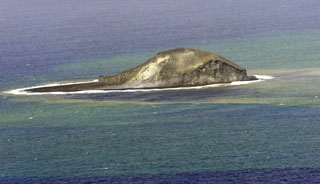Report on Home Reef (Tonga) — 16 July-22 July 2025
Smithsonian Institution / US Geological Survey
Weekly Volcanic Activity Report, 16 July-22 July 2025
Managing Editor: Sally Sennert.
Please cite this report as:
Global Volcanism Program, 2025. Report on Home Reef (Tonga) (Sennert, S, ed.). Weekly Volcanic Activity Report, 16 July-22 July 2025. Smithsonian Institution and US Geological Survey.
Home Reef
Tonga
18.992°S, 174.775°W; summit elev. -10 m
All times are local (unless otherwise noted)
The Tonga Geological Services reported no signs of activity at Home Reef during 5-19 July. A weak thermal anomaly in the crater was identified in a satellite image on 11 July. Discolored water around the island was visible in clear satellite images on 11 and 16 July. Yellowish sulfur deposits in and around the crater were visible in the 16 July image, but no fresh tephra deposits were noted. The dimensions of the crater remained unchanged and were estimated to be 210 m N-S and 120 m E-W. The Aviation Color Code remained at Yellow (the second lowest level on a four-level scale, the Maritime Alert Level remained at Orange (the third level on a four-level scale) with advice to stay at least 2 nautical miles (3.7 km) from the island, and the Alert Level for residents of Vava’u and Ha’apai remained at Green (the first level on a four-level scale).
Geological Summary. Home Reef, a submarine volcano midway between Metis Shoal and Late Island in the central Tonga islands, was first reported active in the mid-19th century, when an ephemeral island formed. An eruption in 1984 produced a 12-km-high eruption plume, large amounts of floating pumice, and an ephemeral 500 x 1,500 m island, with cliffs 30-50 m high that enclosed a water-filled crater. In 2006 an island-forming eruption produced widespread dacitic pumice rafts that drifted as far as Australia. Another island was built during a September-October 2022 eruption.

